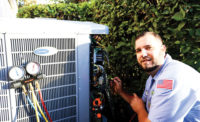With the availability of hot new items like Wi-Fi thermostats at big-box stores and online retail giants like Amazon, more and more homeowners are choosing to buy and install products themselves rather than go through a contractor. In fact, the do-it-yourself (DIY) smart home market, which the thermostat is indeed a part of, is expected to grow in the U.S. from $1.3 billion today to $7.8 billion by 2019, according to a report by NextMarket Insights.
If this is indeed the trend over the next couple of years, it could present a problem to contractors. Not only would they lose out on a sale, but they could see an increase in service calls over malfunctioning equipment.
Do or Don’t
“A lot of people think it’s an easy thing to do, and we’re finding that most homeowners who make that (DIY) attempt actually create additional problems or they short a transformer or blow the fuse on their furnace board,” said Paul Sammataro, owner, Samm’s Heating and Air Conditioning, Plano, Texas. “It’s not as prevalent as you would think with all those thermostats available out there. I would say in the course of a month, you might see it once. But I’m sure it’s going to become more prevalent as time goes on. I think automation is still up-and-coming, so to speak, and as people become more automated with different things, they’re going to make that attempt themselves.”
Brian Turner, service manager at Nerthling’s Heating and Air Conditioning in Erie, Pennsylvania, said the main problem with DIY thermostats is the hassle an installation can bring if the installer runs into an issue.
“If there is a problem with the thermostat, the homeowner will have to return it and get a different one, causing more downtime of the system and more time wasted,” Turner said. “Generally, the warranty on store-bought thermostats is two years. Most professionally installed thermostats will have five years on parts and sometimes will include a labor warranty as well. There is a lot to be said about not having to worry and letting the professionals take care of it.”
Sammataro said it’s not uncommon for homeowners to buy the wrong thermostats for their systems.
“The simplest ones we see is they have a two-stage furnace, let’s say, and they pick up a single-stage thermostat,” Sammataro explained. “So now they open it up and, for instance, some of those thermostats just show you how to hook up a single-stage unit or the consumer doesn’t know the difference between a single- and two-stage unit. They’re not sure how to wire it, or it’s an improper thermostat, altogether.”
Eric Pullen, owner, Pullen Air Conditioning Inc., New Orleans, said his company catches issues with DIY thermostat installations while on calls for other problems.
“Higher-efficiency systems, the multistage units with the new communicating systems, are not going to be compatible with the thermostats that some people buy,” Pullen said. “So, for however long they’ve had it installed, they may not have gotten the efficiency or the function of the equipment that they’ve paid for.
“We’ll notice it when we do a cycle check,” Pullen continued. “We’re making sure both stages come on or the heat pump isn’t working properly and that’s when we’ll catch the problem and trace it back to the thermostat. It’s either the wires aren’t connected properly or all the wires aren’t connected, so we alert the customer. It’s got to be done with little kid gloves; you don’t want to make them feel stupid.”
Cost Comparison
Many homeowners embark on a DIY project in an effort to save a few bucks. These individuals react adversely when the price of the subsequent service call to fix a thermostat issue trumps the initial cost of the device.
Pullen said if the problem is something simple, and his company is already at the house, there is no additional charge, but the homeowner will have to pay for the diagnostic time.
Sammataro does his best to put a positive spin on any call he receives from a DIY project gone wrong.
“It’s not just ‘hey, this customer tried to put in his own thermostat and he’s having problems so it’s his own fault’ type of thing,” he said. “I don’t take that attitude. I look at it as an opportunity to talk to the customer, because obviously they felt capable. I see if I can direct them over the phone and if I can, I will. My saying is that advice is free. If it comes to the point where it’s a dead end, I’ll explain our cost and then explain additional costs of what we might find when we get there, which they can approve or decline for repair,” Sammataro said. “Even though this customer’s a do-it-yourselfer, there’s not a high probability that he’s going to take his air conditioner apart to maintain the system. He may need professional help in the future, and I want him to remember our name when he does.”
Sammataro referenced a recent example where his advice sprouted a budding relationship with a new customer. “A guy was interested in home automation and he liked the idea of including his thermostat, so when he called me with questions about hooking his unit up, I asked him if he had heard about the system we offered and the flexibility and the ability to expand on it versus some of the popular models on the market,” Sammataro said. “After a short conversation, he took his thermostat back and we put ours in, along with three cameras.”
Sammataro said he understands contractors’ frustration with the do-it-yourself market because big-box stores have more buying power and can, therefore, sell products at lower prices.
Face Your Fears
Joe Ramunni, HVAC forced-air zoning specialist, J. Ramunni Consulting LLC, Wadsworth, Ohio, said he is amazed at the fear contractors have at losing their stronghold on the thermostat and control market. Instead of being afraid, Ramunni said contractors need to get serious about competing in a changing world.
“Contractors are going to have to reinvent themselves,” Ramunni said. “They are being left behind because they refuse to accept the changing marketplace. Is it unfair? Not really. Contractors have had a somewhat unfair monopoly on HVAC controls for the past several decades. We all know that the Internet has changed and will continue to change this in multiple ways. Consumers can now be marketed to directly, purchase directly, and, if they go to YouTube, can be instructed on how to install their choice in comfort and/or energy-saving controls directly. We need to learn from the automotive dealers; there are many people who have no desire to do their own automobile repairs, and there are some that do. They provide the best service they can and charge the rate they require. What they don’t do is waste their time and energy boycotting the $3 billion online replacement parts industry. Instead, they continually reinvent themselves to better serve and to earn a profit from the marketplace as it changes.”
Publication date: 9/22/2014
Want more HVAC industry news and information? Join The NEWS on Facebook, Twitter, and LinkedIn today!










